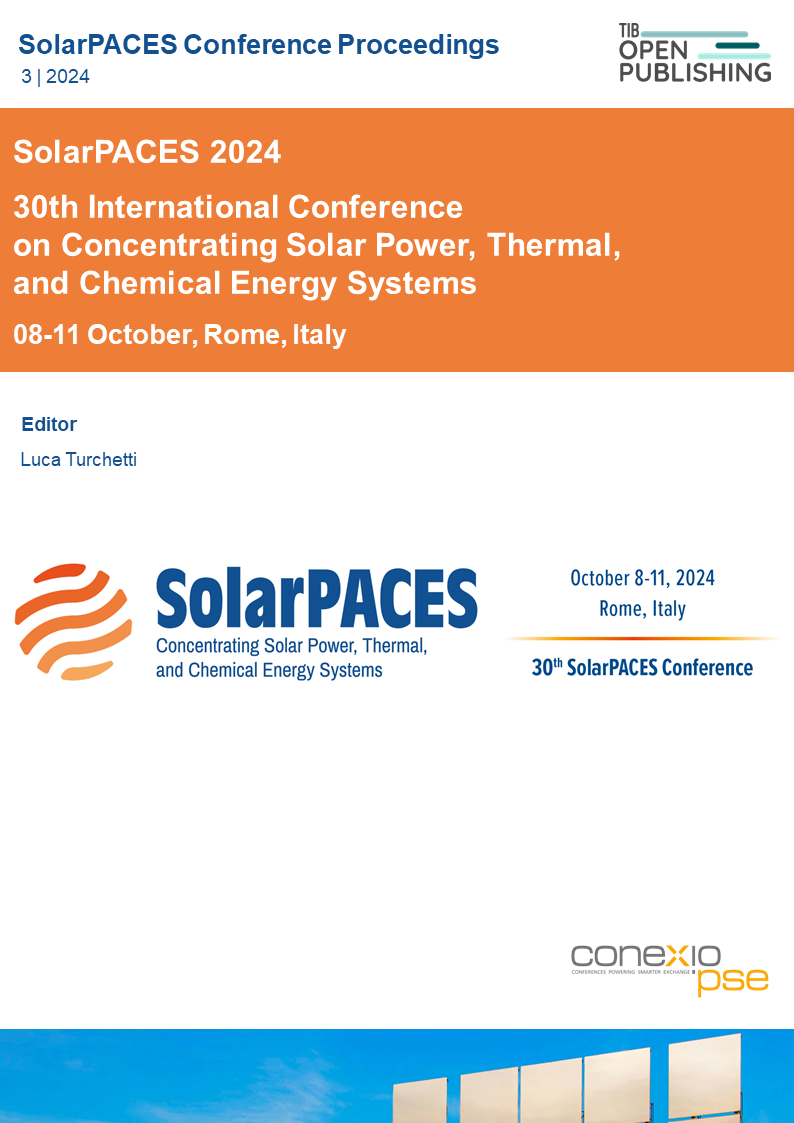Effect of Compressor Inlet Swirl on Solar Gas Turbine Performance
DOI:
https://doi.org/10.52825/solarpaces.v3i.2414Keywords:
Solar Gas Turbine, Inlet Guide Vanes, SwirlAbstract
An investigation of the effect of various compressor inlet guide vane (IGV) setting angles on the thermodynamic performance of a simple single shaft solar-hybrid gas turbine power generation system (SHGT) is presented. The formulation of models for the individual system components is described, with emphasis on the generation of compressor characteristics for various IGV setting angles. Matching of the components in the integrated system model is shown, for the standard single shaft turboshaft configuration as well as several variable rotor speed turboshaft configurations. The estimated fuel consumption, solar receiver effectiveness, and thermal efficiency are compared for the reference system, SHGTs with IGVs, and variable rotor speed SHGT configurations. The results of the performance calculations for a 40 kWe gas turbine engine indicate that a 4.3 % reduction in full-load fuel consumption is attainable with compressor IGVs set at 9° in the direction of the rotor blade rotation, and a reduction of 25.3 % is attainable with independent and distinct compressor and turbine rotor speeds.
Downloads
References
[1] M. R. Meas, T. W. von Backström, and S. J. van der Spuy, “Performance analysis of variable speed solar gas turbine configurations”, AIP Conference Proceedings, vol. 2445, 2022. DOI: https://doi.org/10.1063/5.0086271.
[2] R. V. Luiten, Performance Improvement of the Rover 1S/60 Gas Turbine Compressor, master’s thesis, 2015.
[3] R. Aungier, Centrifugal Compressors: A Strategy for Aerodynamic Design and Analysis (ASME Press, New York, 2000).
[4] A. L. de Wet, Performance Investigation of a Turbocharger Compressor, master’s thesis, 2011.
[5] J. Kurzke, GasTurb 13: Design and Off-Design Performance of Gas Turbines, Manual, (GasTurb GmbH, 2018).
[6] H. I. H. Saravanamuttoo, G. F. C. Rogers, H. Cohen, P. V. Straznicky, and A. C. Nix, Gas Turbine Theory (Pearson, 2017), 7th Edition.
[7] P. Gauche, S. Pfenninger, A. J. Meyer, T. W. von Backström, and A. C. Brent, “Modeling dispatchability potential of CSP in South Africa”, in Proceedings of the first Southern Afri-can Solar Energy Conference, Cape Town, South Africa, 2012.
[8] W. B. Stine and M. Geyer, Power from the Sun, 2001. ISBN 0036-8075. Available at: http://www.powerfromthesun.net/book.html
[9] W. G. Le Roux, T. Bello-Ochende, and J. P. Meyer, “The efficiency of an open-cavity tubular solar receiver for a small-scale solar thermal Brayton cycle”, Energy Conversion and Management, vol. 84 pp.457–470, 2014. DOI: https://doi.org/10.1016/j.enconman.2014.04.048
Published
How to Cite
Conference Proceedings Volume
Section
License
Copyright (c) 2025 Matthew Meas, Johan van der Spuy, Andrew Gill

This work is licensed under a Creative Commons Attribution 4.0 International License.
Accepted 2025-05-06
Published 2025-10-22
